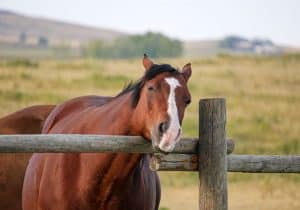6 Steps to Managing Horses With Hock Arthritis

It might start with a slight tendency to deviate to the right or left or a bit of stiffness under saddle. The first sign you see could even be a sore back, and you’ll think a chiropractic session will do the trick. Whatever happens to prompt the lameness investigation, a diagnosis of hock arthritis leaves you with important management decisions to make with your veterinarian.
1. Know which hock joints and other structures are affected.
The hock is actually a complex of five joints including the tibiotarsal (tarsocrural), talocalcaneal, proximal intertarsal, distal intertarsal, and tarsometatarsal, comprising 12 interlocking bones, and usually sliding across each other during movement.
The upper joint, the tarsocrural, is very mobile and responsible for all of the of the flexion and extension of the hock during limb movement, says Michelle L. Delco, DVM, PhD, Dipl. ACVS, the Harry M. Zweig assistant research professor in Equine Health and orthopedic surgeon at Cornell University College of Veterinary Medicine, in Ithaca, New York.
By contrast, the lower joints move relatively little and mostly provide shock absorption. “They’re flat, stacked joints, and (they) take a lot of pounding,” Delco says.
Vets can pinpoint the hock as the source of hind-limb lameness through nerve and joint blocking. Most of the time, hock arthritis in sport horses occurs in the lower joints, in a condition commonly known as bone spavin. But arthritis can also occur in the upper joint, which has slightly different treatment options, so it’s important for vets to precisely identify the disease’s location within the hock through radiographs, she says.
Meanwhile, vets should run additional imaging to check for related issues, such as injuries to the upper sensory ligaments or osteochondrosis dissecans. These issues need treatment as well; the risk is that treatment for hock arthritis might mask their signs, resulting in them getting overlooked. “I always try to make sure we’ve ruled out problems that masquerade as low hock joint arthritis, the classic being high suspensory pain,” she says. “Lameness in these areas often overlap, and they are two of the most common problems in sport horses. The longer (we let) ligament and tendon injuries go undiagnosed and untreated, the less likely we are to get those horses sound for the long run.”
2. Treat pain and inflammation with NSAIDs and/or steroids.
Horses with arthritic hocks generally need pain relief. A first, basic step can be a week or two of oral non-steroidal anti-inflammatories (NSAIDs) like phenylbutazone (Bute), says Delco.
But NSAIDs come with side effects, and the pain will come back—often more pronounced—once treatment stops, she adds. For longer-lasting relief, corticosteroid injection into the joint is an option. Depending on the horse, the state of disease, and the choice of drug, the effects could last for weeks to months or even a full year.
“A single steroid injection is likely to be the most effective treatment for quieting down inflammation inside the joint and relieving pain; it’s hard to deny that,” she says. “I would expect that the horse would feel fantastic. He’ll feel like a new horse for months, if (hock arthritis) is all we’re dealing with.”
Depending on the client’s needs and training schedule, James Carmalt, MA, VetMB, MVetSc, PhD, FRCVS, Dipl. ABVP, AVDC, ACVSMR, ACVS, professor of equine dentistry, surgery, sport medicine & rehabilitation at the University of Saskatchewan’s Western College of Veterinary Medicine, in Saskatoon, Canada recommends either fast-acting triamcinolone or methylprednisolone acetate, which tends to have a longer-lasting effect but “takes a little longer to kick in.” The fast-acting steroid could be a good solution for a horse with an event coming up in two weeks that’s then going on a two-month winter break, he says. The longer-lasting option would be better for those at the start or middle of their active working seasons.
But steroid injections come at a cost, Delco says. For one, they work so well, they could mask other injuries that continue to worsen without treatment—especially since steroids can suppress the immune system and “shut down healing,” she says.
And any time a joint is injected, there’s a risk—albeit slight—of joint infection, Carmalt says.
Most importantly, repeated steroids “hasten the breakdown” of cartilage and speed up arthritic degeneration, Delco explains. “We don’t like to inject steroids more than every six months,” she says. “We like to be as sparing as we can.”
To try to counteract the effects of the steroids, Delco says she usually also injects hyaluronic acid, mainly to promote cartilage health and the joint’s own lubrication properties, allowing it to glide more easily. That’s especially important for the high-movement upper hock joint, she explains. But she frequently uses hyaluronic acid in the lower joints as well because of its anti-inflammatory properties.
3. Consider orthobiologics.
When veterinarians inject platelet-rich plasma (PRP), interleukin-1 receptor antagonist protein, and other similar orthobiologics into an arthritic hock, the therapies can reduce inflammation and relieve pain, says Delco. Autologous protein solution (APS) and alpha 2 macroglobulin (A2M) are two other blood-based therapeutic products. “And there are many other ‘biologic’ therapies that have come onto the market recently,” she adds.
A big advantage of orthobiologics is that, unlike steroids, they have fewer side effects. “Rather than inhibiting healing and hastening the arthritic process, they can actually have pro-healing effects and be beneficial to joint health,” Delco says.
Treatment response, however, isn’t as predictable as it is for steroids. “I’ve found that some horses respond really well to certain therapies of this type, and others respond better to a different one,” she explains.
Treatment options also vary according to which joints are affected and the stage of disease, Delco adds. “Low hock joints are very small, which limits the volume we can inject,” she says. “As the joint breaks down, there is less and less space to put our treatment. So if you are going to try a biologic, start early, not as a last resort.”
4. Consider fusion therapy.
Arthritis is painful primarily because the bones in the joint grind together as they slide across one another due to a lack of cartilage. In the lower hock joints, however, the bones can function well without moving.
For that reason, veterinarians can fuse those lower hock joints together permanently so they don’t slide, without affecting horses’ leg movements or reducing their performance, says Carmalt. “So, no movement, no pain.”
This is not a viable option for the upper hock joint, given its movement functions, he says.
5. Slow disease progression and increase comfort.
Hock arthritis is usually diagnosed in middle-aged sport horses, generally when the disease is mild enough to be primarily a performance issue, Delco says. Over time, though, it will worsen, regardless of treatment. It can’t be healed or stopped.
“It’s the nature of the disease,” Carmalt says.
You might, however, be able to slow disease progression, says Delco. “Anecdotally, we believe certain treatments do help slow down arthritis,” she explains. “There’s just not great evidence yet that they actually work.”
Injecting hyaluronic acid into the joint might effectively offset the disease acceleration caused by steroid use, Delco says. “Lubricating that sliding motion of the cartilage against itself is really critical for slowing down that arthritis process.”
Polysulfated glycosaminoglycan works in a similar way to hyaluronic acid, she adds. As an intramuscular injection, it promotes good joint health and might help slow arthritis.
The most likely way to delay hock arthritis is to keep exercising, at least at a low level, Delco says. Muscular fitness helps stabilize the joints and has an important effect on the cartilage. Joint fluid takes over the role of blood vessels—which are essentially absent in cartilage—providing nutrients and taking out waste, she explains. Exercise pumps the fluid, keeping that exchange process active.
While studies in horses are lacking, research on human arthritis has shown that low-grade walking exercise every day is the only therapy proven to slow arthritis. “It’s better than any drug on the market,” Delco says.
The worst situation for horses with arthritic hocks is to leave them for long periods of rest and then work them hard, she adds. “Staying fit and in consistent work really makes a difference.”
Regular exercise can also help keep horses’ body weight down, which—even though the hind limbs only carry about 30% of the horse’s mass—can help relieve pressure on the joints, says Carmalt.
Unlike for soft tissue injuries, rest provides no real benefits for arthritis aside from relieving pain due to reduced effort on the joint, he explains. “Rest isn’t going to slow down the arthritic process to any massive degree,” he says.
Soft footing and bedding work like the “spongy” insoles humans sometimes wear when they have arthritis in their knees, Carmalt says. They might make the patient more comfortable, “but it won’t stop the progression of the arthritis.”
Finally, it’s important to resolve any other issues in the hock, such as bone chips, as these simultaneous disease processes can otherwise hasten arthritis, she says.
6. Recognize and keep track of subtle signs of discomfort.
When treatment wears off or the disease progresses enough, horses can start experiencing performance-limiting pain again. Jumping horses, for example, might “drift”—gradually displacing toward the left or right—over fences, Carmalt says. Reining horses might show sit-stand-sit sequences and even slight pivoting during slides. In barrel horses, classic signs include a reluctance to hug the barrel and increased pattern times.
When the intervals between treatments get too short, it’s time to change the plan, Delco says. “If you’re getting down to every four or five months, you’re nearing the end of the effectiveness of those injections.”
This might mean it’s time for owners to have an honest conversation with their vets—and themselves—to decide the next steps, says Carmalt. “I’m particularly blunt at talking to clients about this stuff,” he says. “And I’ll say, ‘Those expectations are unreasonable.’”
However, horses with advanced hock arthritis don’t necessarily need to retire, our sources agree. “A lot of these horses can be repurposed,” Carmalt says. “You’ve just got to reduce the workload in their jobs.”
Take-Home Message
When horses develop arthritis in their hocks, they need a management plan that corresponds to both the horse and the owner. As the disease progresses—as it inevitably will—owners might need to adjust that plan and eventually consider a lower workload. The key to success is a good working relationship with your veterinarian, says Delco. “It’s really important to work with a veterinarian, consistently, who knows you and knows your horse very well. That way, you can make the right decisions for you and your horse.”

Written by:
Christa Lesté-Lasserre, MA
Related Articles
Stay on top of the most recent Horse Health news with















